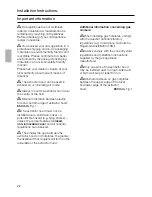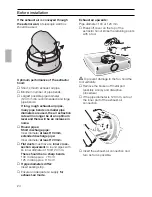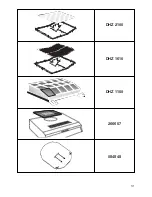
24
Before installation
Optimum performance of the extractor
hood:
❑
Short, smooth exhaust-air pipe.
❑
Minimum number of pipe bends.
❑
Largest possible pipe diameter
(120 mm dia. recommended) and large
pipe bends.
If long, rough exhaust-air pipes,
many pipe bends or smaller pipe
diameters are used, the air extraction
rate will no longer be at an optimum
level and there will be an increase in
noise.
❑
Round pipes:
Short discharge pipe:
Inner diameter
at least 100 mm,
extended discharge pipe:
Inner diameter
at least 120 mm.
❑
Flat ducts
must have an
inner cross-
section equivalent
to round pipes with
an inner diameter of 100/120 mm.
There should be no sharp bends.
100 m dia approx.
1
78 cm
2
125 m dia approx. 113 cm
2
❑
If pipe diameters differ:
Insert sealing strip.
❑
Ensure an adequate air supply
for
exhaust-air mode
.
If the exhaust air is conveyed through
the exterior wall,
a telescopic wall box
should be used.
Exhaust air upwards:
Pipe diameter: 100 or 120 mm
❑
Break off cover on the top of the
extractor hood; strike the retaining points
with a tool.
To prevent damage to the fan, hold the
tool vertically.
❑
Remove the broken off metal part
(possibly a noisy and disruptive
procedure).
❑
If the pipe diameter is 120 mm, cut out
the inner part of the exhaust-air
connection.
❑
Insert the exhaust-air connection and
turn as far as possible.








































